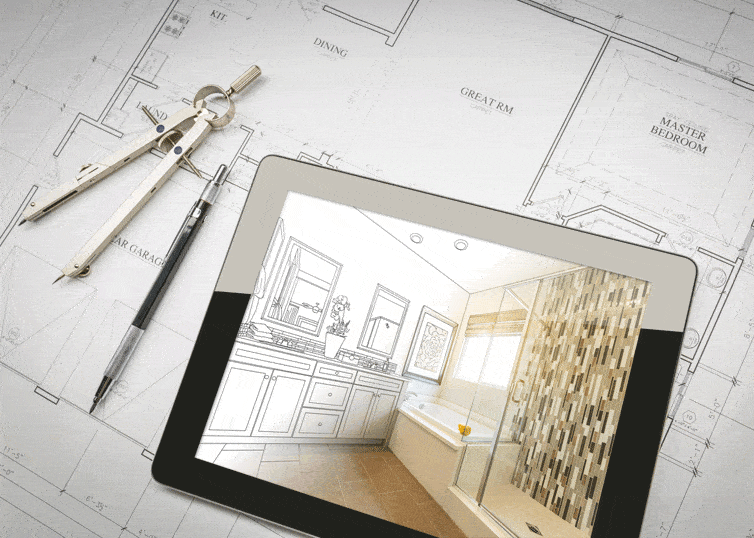When it comes to real estate appraising, kitchens often play a pivotal role in determining a home’s value. A well-appointed kitchen can significantly enhance a property’s appeal and marketability. As an appraiser, understanding the nuances of kitchens is essential to providing credible and insightful valuations. Let’s dive into appraising kitchens and how the room impacts market value.
Want to learn more about appraising kitchens, bathrooms, and the various elements that make up a residential property? Enroll in our top-rated CE course: Residential Construction and the Appraiser.
The Heart of the Home
Now more than ever, kitchens are more than just a place to cook; they are a focal point for social gatherings and a showcase of the homeowner’s taste and lifestyle. Whether it’s a formal and elegant kitchen, a country-style haven, or a sleek modern space, the design and functionality of a kitchen is paramount.
While appraisers do not base their valuations on the emotional appeal of a kitchen, we do consider its marketability. Kitchens are among the most expensive rooms in a home, and as appraisers, we must evaluate their upgrades, functionality, and conformity to competitive properties.
A modernized kitchen often has updated appliances, finishes, and design elements that align with current market trends, which can increase a property’s appeal and, consequently, its market value. On the other hand, a functional but outdated kitchen might not attract the same buyer interest or command the same price.
Appraisers must also consider how the kitchen aligns with the home’s style and price point. It’s a balancing act. For example, a modestly priced, small log home in a rural, wooded area would not typically feature sleek metal cabinets and advanced technology, as these features don’t align with the home’s rustic style.
In this case, we would need to assess whether the kitchen meets the expectations of typical buyers for that type and style of home. This assessment includes evaluating the features, size, and modernization of the kitchen to ensure they are consistent with comparable homes in the market area.
Key Kitchen Trends
Kitchen trends evolve almost as frequently as hairstyles and fashion. What was popular a decade ago may no longer be in demand. Therefore, when evaluating a kitchen’s level of modernization, it’s essential to determine if it aligns with current market trends. Let’s explore some current kitchen trends.
1. Multiple Work Zones
Traditional small kitchens designed with the “kitchen triangle” concept have given way to modern kitchens featuring multiple work zones. Contemporary kitchens are often designed with specific zones for different activities. These may include a cooking zone with the stove and oven, a prep zone with ample counter space, a cleaning zone near the sink and dishwasher, and even a socializing zone with seating at an island or breakfast bar.
These contemporary kitchens serve as the heart of the home, accommodating not just cooking and dining but also socializing and work activities.
2. Layout and Size Evolution
Older homes, especially those built in the 1950s and 1960s, often feature galley kitchens located at the back or in a corner of the home. In contrast, modern homes typically place the kitchen at the center of the floor plan, reflecting its role as a central gathering space for daily activities and social interaction.
Appraisers must not only consider if the layout allows for efficient workflow, but also if the size meets the typical buyer’s expectations for that style of home and price point. Modern kitchens are now expected to serve multiple uses, requiring additional space. Therefore, it is crucial that the appraiser evaluate the kitchen’s size in proportion to the house style, overall size, and comparable properties in the market.
3. Cabinetry
Kitchen islands have been popular for over a decade, but they’ve now grown larger, often exceeding seven feet in length, and include additional workspace and storage. Higher-priced homes might even feature two kitchen islands.
Cabinetry has also evolved, combining different materials and blending traditional and modern elements, often with crown molding yet maintaining a sleek, contemporary design. Open shelving in place of upper cabinetry remains popular, but many buyers now seek customized cabinetry with storage solutions like hidden spaces for appliances and integrated, concealed pantries. A mix of materials, colors, and finishes are now widely accepted.
While it may seem that anything goes with cabinetry, the trending focus is on customization, and creating a high-end yet minimalist look and functionality.
4. Countertops
When evaluating kitchen countertops, a variety of materials are currently popular, including stainless steel, butcher block, granite, soapstone, and marble. Among these, quartz and quartzite have emerged as frontrunners, appealing to homeowners across various price points and markets.
With so many options available, it’s important to stay abreast of the prevailing trends to ensure that any upgrades align with what typical buyers seek. Currently, there is a strong preference for countertop materials that exude a natural aesthetic, offer functionality, and are sustainable. In contrast, darker granite colors may be seen as outdated. Laminate countertops are not necessarily considered outdated, but their popularity has waned in recent years as consumers increasingly prefer more upscale materials.
When appraisers assess countertops, they need to take into account the material, condition, quality of installation, and current market trends in comparable homes within the area.
5. Flooring
Current kitchen floor trends focus on smooth surfaces, wide planks, and raw wood tones. Lighter wood hues like white oak and maple are becoming more popular, while rustic wood with saw marks, knots, and heavy graining continue to be favorites. Additionally, terracotta, luxury vinyl, concrete, and upgraded tiles are popular choices, with designs incorporating larger tiles or wider planks.
Appraisers should primarily evaluate the level of upgrades and the condition of the floor covering, ensuring it aligns with market expectations and the home’s overall style.
6. Appliances
For real estate appraisers, understanding home appliance trends for those appliances that are not considered personal property can offer insight into property value shifts. Multifunction appliances, sustainable materials, and smart features—like large sinks with smart faucets—are gaining popularity. High-end homes are embracing luxury items like double appliances and walk-in refrigerators, while minimalism and hidden appliances cater to those seeking sleek aesthetics. Due to environmental concerns, induction stoves are gaining traction over gas cooktops.
Stainless steel appliances are not considered outdated, but they are no longer the only preferred option in modern home design. While they remain a popular and timeless choice, newer trends are emerging. These trends include matte finishes, such as matte black or bronze, and more colorful appliances.
7. Sustainability and technology
As sustainability and technology reshape the market, keeping an eye on these trends can help appraisers assess the kitchen’s appeal and functionality. This includes cabinetry with built-in charging stations, and smart lighting. Eco-friendly materials and energy-efficient appliances have become increasingly sought after, reflecting a growing commitment to environmental sustainability.
This trend includes the use of recycled glass countertops, reclaimed wood cabinetry, bamboo cabinetry, and appliances with ENERGY STAR certification. Additionally, water-efficient fixtures, such as low-flow faucets and water-saving dishwashers, are also in high demand.
While keeping up with kitchen trends is essential, appraisers must also consider how these updates interact with broader appraisal concepts such as functional obsolescence, local market trends, and conformity. Understanding these factors helps ensure a credible appraisal.
Key Concepts to Appraising Kitchens
Trends
Stay informed about current trends in kitchen design and technology. While national trends can provide insights, local market knowledge is indispensable. Engage with local builders, real estate agents, and contractors to understand what kitchen features are most valued in your area.
Quality and Condition
Assess the quality, age, and condition of the kitchen’s components. Any signs of wear or outdated features should be noted, as they can affect the overall market value. Appraisers should examine and note the quality of materials used in the kitchen, such as countertops, cabinetry, flooring, and appliances.
High-quality materials (like custom cabinetry) can enhance a property’s value, while lower-quality materials (like laminate countertops or basic cabinetry) may not.
Cost vs. Value
Understand the difference between cost and value. While a fully renovated kitchen can be expensive to install, its value is determined by how much it enhances the home’s appeal to potential buyers.
A kitchen that aligns with buyer expectations and market trends will add more value than one that is simply costly. Homeowners often assume that a $50,000 kitchen renovation will directly increase their home’s value by the same amount, but this isn’t typically the case. Much of that renovation cost goes toward retrofitting, replacing old systems, and bringing the kitchen up to date, rather than purely adding value.
While a modernized kitchen can certainly make a home more appealing to potential buyers, appraisers must keep in mind that other homes in the neighborhood likely have fully functioning kitchens, even if they aren’t as high-end. Typically, the market won’t adjust to the full renovation cost, as buyers are primarily paying for a functional space that meets their needs, rather than the full price of a renovation.
Functional Obsolescence and Price Point
If a back corner kitchen or a galley kitchen does not align with current market preferences for homes of a similar age, it might be considered outdated and impact marketability. However, this does not necessarily rise to the level of functional obsolescence that must be remedied. An outdated but functional kitchen might not be a major concern in lower price ranges.
Conversely, in high-end homes, buyers expect the latest designs, features and finishes; and therefore, an outdated kitchen may be considered as functional obsolescence.
For example, laminate countertops can provide a budget-friendly alternative that still meets the functional needs of a kitchen while offering a modern look. It remains a practical choice for buyers seeking cost-effective solutions, especially in rental properties. Ultimately, whether laminate is considered outdated depends on the target market and local trends; in some areas, it may still be a viable option, while in others, it might be viewed as less desirable compared to more premium materials.
Appeal & Functionality Count when Appraising Kitchens
In conclusion, appraising kitchens requires a thoughtful, balanced analysis of market trends, quality, and functionality. While it’s important to understand current design preferences, the value of a kitchen is ultimately determined by how well it meets the expectations of buyers in a particular market.
A homeowner may have invested heavily in a kitchen renovation, but it is the appraiser’s responsibility to carefully consider factors such as conformity, local market preferences, and house style and price range when valuing the subject property. Remember, ultimately a kitchen’s value lies in its ability to enhance the overall appeal and functionality of the home, not its initial cost or the cost of renovation.
Stay up to date with the latest info regarding the “go-to” handbook for appraisers and lenders in our FHA Handbook 4000.1 continuing education class! Or gain access to all our expertly planned and taught continuing education classes by becoming a member today.






